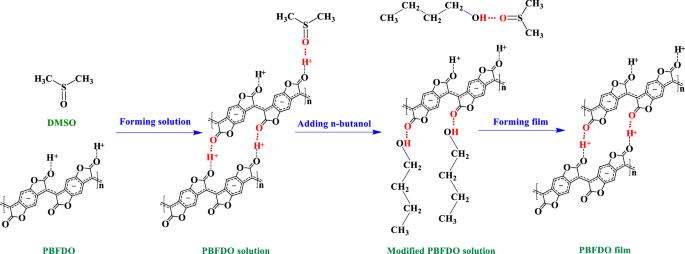Highly conductive polymer electrodes for polymer light-emitting diodes
IF 12.3
1区 材料科学
Q1 ENGINEERING, ELECTRICAL & ELECTRONIC
引用次数: 0
Abstract
Organic light-emitting diodes (OLEDs) offer the advantage of flexibility; however, the use of traditional transparent anode ITO limits further extension of their flexible characteristics. In this study, we propose employing an polymer polybenzodifuranedione (PBFDO) as a flexible transparent anode instead of the rigid ITO. To address the issue encountered during the PBFDO solution spin-coating process, we introduced n-butanol into the PBFDO conductive solution to reduce its viscosity and freezing point by modulating intermolecular hydrogen bonding interactions. Consequently, high-quality PBFDO films with high conductivity, superior transmittance, and low surface roughness were successfully obtained via spin-coating. Moreover, due to its proper work function, regular molecular stacking, and low refractive index properties, PBFDO electrode facilitate efficient carrier injection and transport as well as photon extraction. The resulting device utilizing a PBFDO anode combined with Super Yellow as the light-emitting layer exhibited excellent performance characteristics including a normal threshold voltage of 2.6 V and a maximum luminous efficiency of 12.8 cd A−1 comparable to that device based on the ITO electrode. Furthermore, flexible device also achieved satisfactory performance (7.7 cd A−1) when using the PEN substrate.

用于聚合物发光二极管的高导电性聚合物电极
有机发光二极管(OLED)具有柔性优势,但传统透明阳极 ITO 的使用限制了其柔性特性的进一步扩展。在本研究中,我们建议使用聚合物聚苯二呋二酮(PBFDO)作为柔性透明阳极,以取代刚性 ITO。为了解决 PBFDO 溶液旋涂过程中遇到的问题,我们在 PBFDO 导电溶液中引入了正丁醇,通过调节分子间氢键相互作用来降低其粘度和凝固点。因此,通过旋涂工艺成功获得了具有高导电率、优异透射率和低表面粗糙度的高质量 PBFDO 薄膜。此外,由于具有适当的功函数、规则的分子堆积和低折射率特性,PBFDO 电极可促进载流子的高效注入和传输以及光子萃取。利用 PBFDO 阳极和 Super Yellow 作为发光层的器件具有优异的性能特征,包括 2.6 V 的正常阈值电压和 12.8 cd A-1 的最大发光效率,与基于 ITO 电极的器件相当。此外,当使用 PEN 基底时,柔性器件也达到了令人满意的性能(7.7 cd A-1)。
本文章由计算机程序翻译,如有差异,请以英文原文为准。
求助全文
约1分钟内获得全文
求助全文
来源期刊

npj Flexible Electronics
Multiple-
CiteScore
17.10
自引率
4.80%
发文量
91
审稿时长
6 weeks
期刊介绍:
npj Flexible Electronics is an online-only and open access journal, which publishes high-quality papers related to flexible electronic systems, including plastic electronics and emerging materials, new device design and fabrication technologies, and applications.
 求助内容:
求助内容: 应助结果提醒方式:
应助结果提醒方式:


